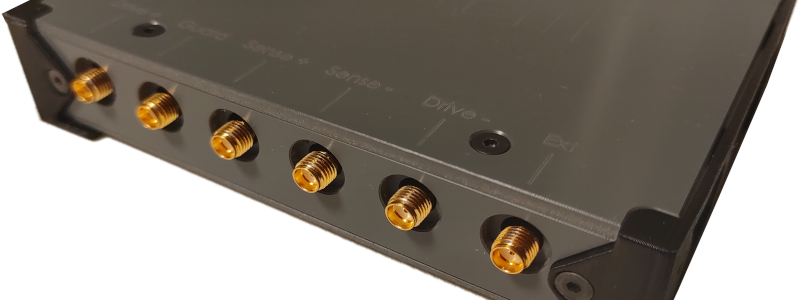Product Navigation

Summary
Compact and resource efficient source-measure unitAlshain Strix is a source-measure unit (SMU) designed & optimised for real world use-cases. A SMU is a truly general purpose DC-measurement instrument as it can both source current and voltage and measure them at the same time. Strix and most other SMUs are designed to work in a fully automated setups and therefore are suitable for testing and quality control of semiconductors and other devices at scale.
Common use cases are:
- Semiconductor characterisation
- IV curve measurements (eg. diode forward voltage, photodiode dark current)
- Multi-terminal device characteristic curves (FET, BJT etc)
- Component testing
- DC amplification
- Leakage current
- Power consumption
- Insulation & contact resistance
- Material sciences
- Electrochemistry (potentiometry, voltammetry, coulometry)
- Piezo electric materials
- Superconductors
- Thin films, graphene etc
Primary design goal for Strix is resource efficiency: compact physical size to reduce lab space requirements, cost efficient performance and ease of use and integration. As these instruments are often used in (semi)automated setups and peforming complex measurements, Strix is engineered to have as clear and concise programming interface as possible without imposing any artificial restrictions. And in order to provide flexibility and scaling, Strix units are designed to be daisy-chained together when more channels or capacity is needed.
In addition to daisy-chaining, Strix units have an extra voltage input ( ±2.5V ) that enables real time monitoring of temperature, laser power, supply voltage etc. It can be used to reduce the amount of instruments needed when doing device characterisation such as LED light output measurements.
More detailed information, Python and LabView libraries, usage and examples are available at project's Github page.
Specifications
Size, capabilities and cost
- Footprint: 130mm x 110mm x 30mm
- True four-quadrant operation
- Max voltage: ±17V
- Max current: ±20mA
- Voltage ranges: ±17V, ±2.5V, ±300mV
- for EXT input: ±2.5V, ±300mV, ±35mV
- Current ranges: ±20mA, ±100µA, ±1µA, ±10nA
- Resolution:
- EXT resolution:
- Typical noise equivalent number of digits: 5 digits ( 200ms integration time )
- See measured noise performace table for more detailed info
- Sub-picoamp current sensitivity at 10nA range
- DC accuracy: 0.02% with factory calibration
- Up to 32 Strix units can be daisy-chained together
- Internally temperature stabilised to minimise drifts and environmental effects
- Connectors: 6x SMA (front panel), 1x 2.6mm DC jack, 2x DSUB9
- Made in Finland
| Voltage range | Measurement | Source |
|---|---|---|
| ±17V | 40µV | 1mV |
| ±2.5V | 5µV | 100µV |
| ±300mV | 650nV | 10µV |
| Current range | Measurement | Source |
|---|---|---|
| ±20mA | 20nA | 1µA |
| ±100µA | 250pA | 10nA |
| ±1µA | 2.5pA | 100pA |
| ±10nA | 25fA | 1pA |
| Voltage range | Measurement |
|---|---|
| ±2.5V | 2.5µV |
| ±300mV | 300nV |
| ±35mV | 40nV |
Prices start from 2890 € + VAT and it can be purchased from our store or request a quote.
Code examples
Strix quick start guide with Pythonimport libStrix import serial # replace "COM3" with corresponding port on your computer com = serial.Serial( "COM3", 460800, timeout = 10.0 ) # Connect to SMU with address = 1 (default) smu = libStrix.Strix( com, 1 ) # Measure both voltage and current voltage, current = smu.measure()
IV-sweep with Python
import sys
import serial
import time
import libStrix
# Open connection to SMU
com = serial.Serial( sys.argv[1], 460800, timeout = 25.0 )
smu = libStrix.Strix( com, 1 )
# Settings
smu.write( libStrix.PARAM_AVERAGES, 5 )
smu.write( libStrix.PARAM_AUTORANGING, libStrix.AUTORANGING_ON )
# Sweep paramters
v_start = -5.0
v_stop = 5.0
dV = 0.1
N = int( abs(v_start - v_stop) / dV ) + 1
# Perform measurements
smu.enable_output( True )
for i in range( N + 1 ):
q = i / N
v = v_start * ( 1 - q ) + v_stop * q
smu.set_drive_voltage( v )
v_meas = smu.measure_voltage()
i_meas = smu.measure_current()
print( v_meas, i_meas )
smu.enable_output( False )
com.close()